





















Four case studies — four approaches to understanding the brain, and their limitations:
"The ACT-R (Adaptive Control of Thought, Rational) theory rests upon three
important components: rational [= "effective + adaptive"] analysis
(Anderson, 1990), the distinction between procedural and
declarative memory (Anderson, 1976), and a modular
structure in which components communicate through buffers."
"The actual substrate of cognition is an interconnected network of neurons. Whether or not this is a significant source of constraint is open to debate."
— Taatgen, N.A. & Anderson, J.R. (2008).
ACT-R.
In R. Sun (ed.),
Constraints in Cognitive Architectures.
Cambridge University Press, 170-185.
"All that there is to intelligence is the simple accrual and tuning of
many small units of knowledge that in total produce complex cognition. The
whole is no more than the sum of its parts, but it has a lot of parts."
— Anderson, J. R. (1996). ACT: A simple theory of complex
cognition.
American Psychologist, 51, 355-365.
"All this knowledge creates a serious problem. How does one select the
appropriate knowledge in a particular context?"
"ACT-R has developed a two-pass solution for knowledge deployment. An initial parallel activation process identifies the knowledge structures (chunks and productions) that are most likely to be useful in the context, and then those knowledge structures determine performance."
— Anderson, J. R. (1996). ACT: A simple theory of complex
cognition.
American Psychologist, 51, 355-365.
"ACT-R is a hybrid architecture in the sense that it has both symbolic and
subsymbolic aspects. The symbolic aspects involve declarative chunks and
procedural production rules. The declarative chunks are the
knowledge-representation units that reside in declarative memory, and the
production rules are responsible for the control of cognition. Access to
these symbolic structures is determined by a subsymbolic level of
neural-like activation quantities."
— Anderson, J. R., & C. Lebiere (2003).
The Newell Test for a theory of cognition.
Behavioral and Brain Sciences 26:587-640.
"ACT-R consists of two key memories — a declarative memory and a
procedural memory.
The system has separate memories for each different
type of chunk — for example, addition facts are represented by one type
memory, whereas integers are represented by a separate type memory."
— Anderson, J. R., & C. Lebiere (2003).
The Newell Test for a theory of cognition.
Behavioral and Brain Sciences 26:587-640.
"Activation [of an item] in ACT-R theory reflects its log posterior odds of being
appropriate in the current context. This is calculated as a sum of the log
odds that the item has been useful in the past (log prior odds) plus an
estimate that it will be useful given the current context (log likelihood
ratio). [This is a Bayesian approach, more about which later.]
Thus, the ACT-R claim is that the mind keeps track of general
usefulness and combines this with contextual appropriateness to make some
inference about what knowledge to make available in the current
context. The basic equation is
Activation-Level = Base-level + Contextual-Priming
— Anderson, J. R. (1996). ACT: A simple theory of complex
cognition.
American Psychologist, 51, 355-365.
"In addition to the learning mechanisms that update activation and
expected outcome, ACT-R can also learn new chunks and production rules."
"New chunks are learned automatically: Each time a goal is completed or a new percept is encountered, it is added to declarative memory. New production rules are learned by combining existing production rules. The circumstance for learning a new production rule is that two rules fire one after another, with the first rule retrieving a chunk from memory. A new production rule is formed that combines the two into a macro-rule but eliminates the retrieval. Therefore, everything in an ACT-R model (chunks, productions, activations, and utilities) is learnable."
— Anderson, J. R., & C. Lebiere (2003).
The Newell Test for a theory of cognition.
Behavioral and Brain Sciences 26:587-640.
"It might seem strange that neural computation should just so happen to
satisfy the well-formedness constraints required to correspond to the
symbolic level of a system like ACT-R. This would indeed be miraculous if
the brain started out as an unstructured net that had to organize itself
just in response to experience. However, as illustrated in the tentative
brain correspondences for ACT-R components [next slide] and in the [preceding]
description of ACT-RN, the symbolic structure emerges out of the structure
of the brain."
— Anderson, J. R., & C. Lebiere (2003).
The Newell Test for a theory of cognition.
Behavioral and Brain Sciences 26:587-640.
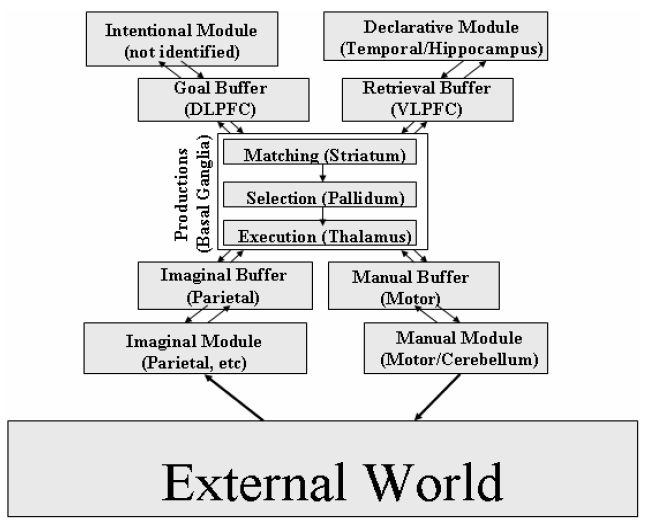
The organization of information in ACT-R. Information in the buffers
associated with modules is responded to and changed by production
rules.
DLPFC: dorsolateral prefrontal cortex; VLPFC: ventrolateral
prefrontal cortex.
— Anderson, J. R., et al. (2004).
An Integrated Theory of the Mind.
Psychological Review 111:1036-1060
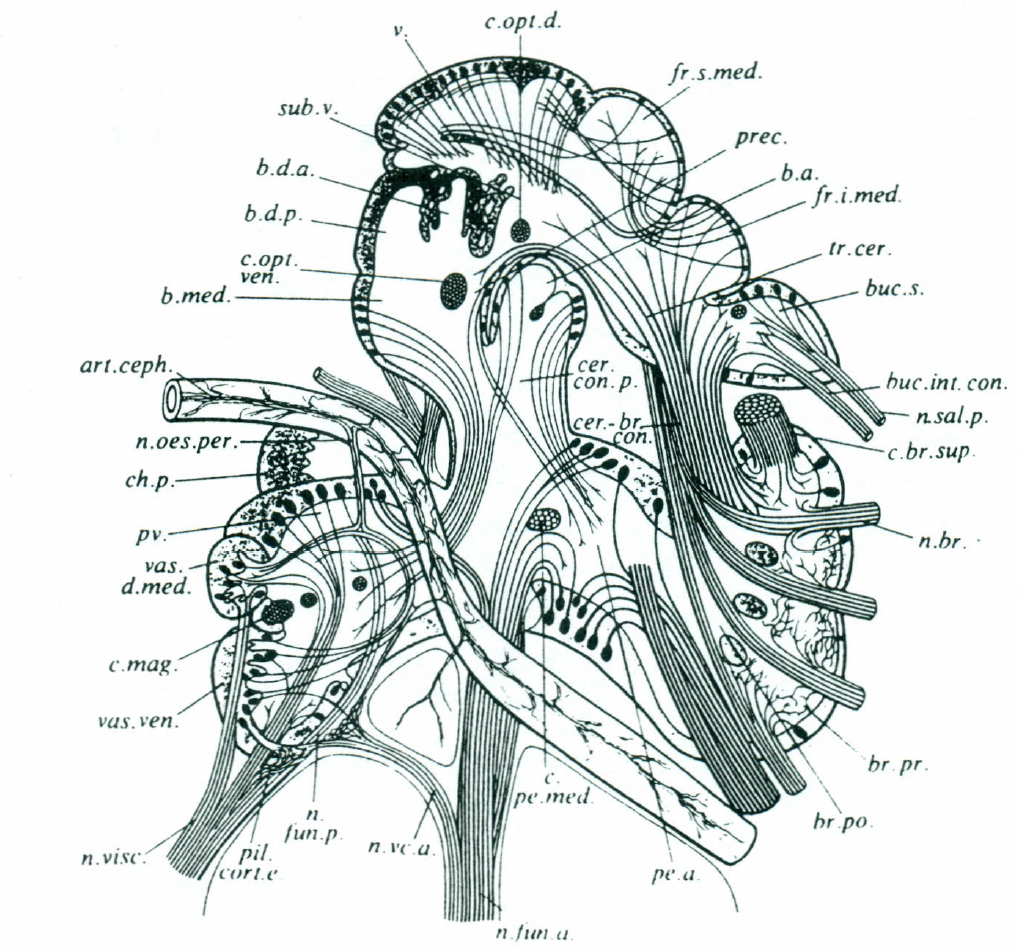
On the right: octopus central nervous system (Fig. 6B from The cephalopod nervous system: What evolution has made of the molluscan design, B. U. Budelmann, 1995).

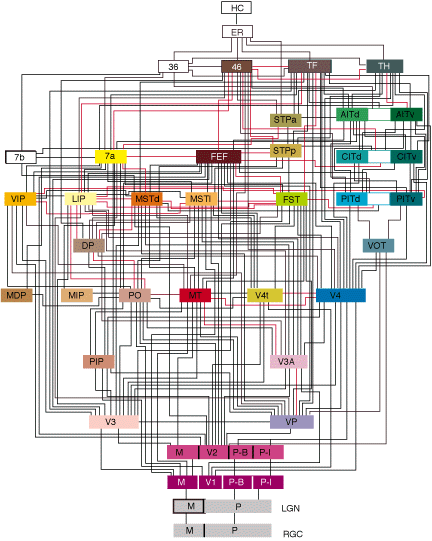
Felleman, D. J., and D. C. Van Essen (1991).
Distributed hierarchical processing in the primate cerebral cortex.
Cerebral Cortex 1:1-47.
"Sometimes the suspicion is stated that ACT-R is a general computational
system that can be programmed to do anything. To address this issue, we
would like to specify four senses in which the system falls short of
that.
— Anderson, J. R., & C. Lebiere (2003).
The Newell Test for a theory of cognition.
Behavioral and Brain Sciences 26:587-640.
Localized brain stimulation for diagnostic purposes, pioneered by Wilder
Penfield, or: how to smell
burnt toast that's not there —
Motion is a powerful cue to 3D structure and to "abstract"
features of the moving object:
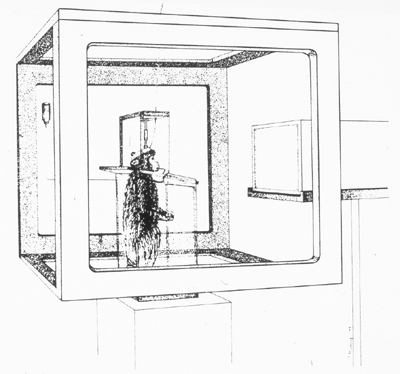
|
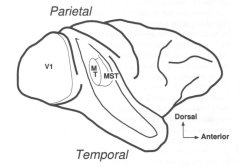
cortical area MT, which "specializes" in motion processing |
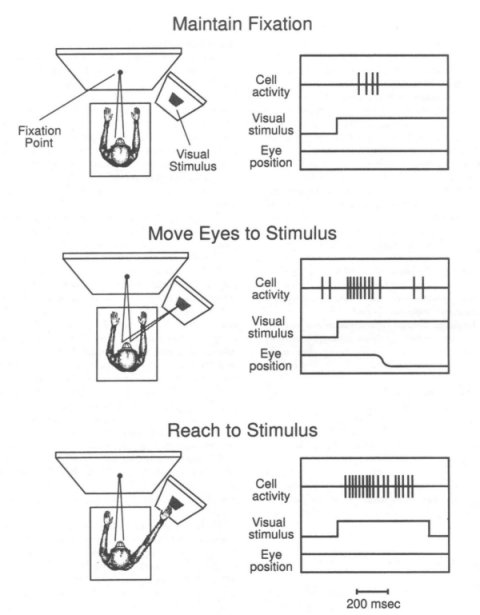
Behavioral tasks:
The data: parallel recordings of —
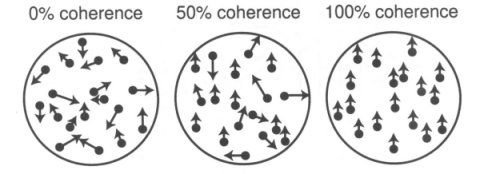
The behavioral task is to detect and signal the direction of coherent motion. Its difficulty (and therefore the performance) depends on the degree of coherence.
| 0% | 5% |
| 30% | 100% |
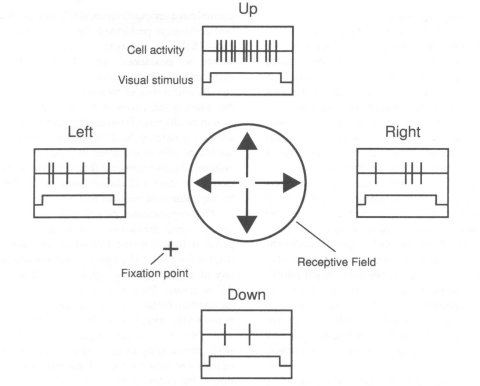 |
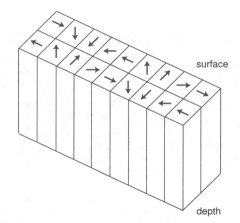 |
| the typical response of a single neuron in area MT | area MT is organized in columns by the neurons' preferred direction of motion |
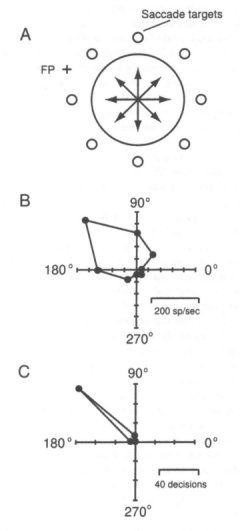
From William T. Newsome's lab (Stanford):
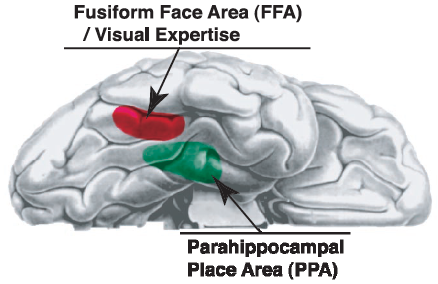
"Schematic diagram illustrating the locations of the fusiform face area
(FFA), which also has been implicated in expert visual recognition, and
the parahippocampal place area (PPA) on the ventral surface of the right
temporal lobe. In most brains, these areas are bilateral."
— J. V. Haxby, M. I. Gobbini, M. L. Furey, A. Ishai, J. L. Schouten, and
P. Pietrini (2001).
Distributed and overlapping representations of faces and
objects in ventral temporal cortex.
Science 293:2425-2430.
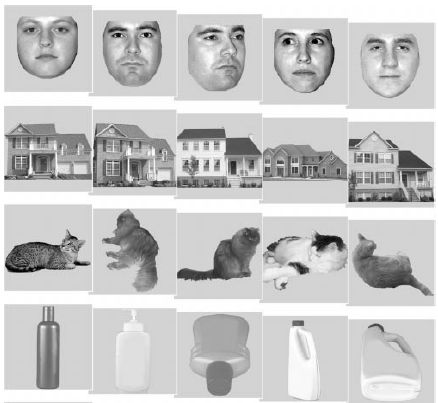
"Examples of stimuli. Subjects performed a one-back repetition detection
task in which repetitions of meaningful pictures were different views of
the same face or object."
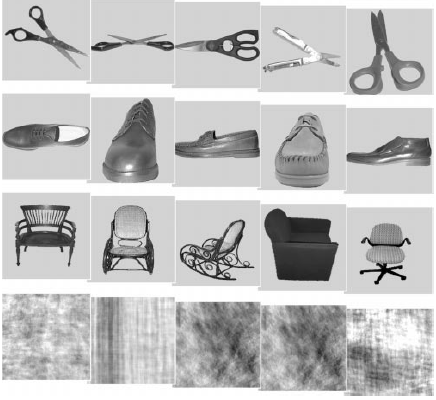
"Examples of stimuli. Subjects performed a one-back repetition detection
task in which repetitions of meaningful pictures were different views of
the same face or object."
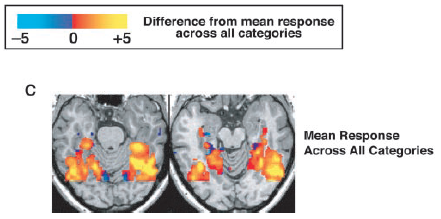
"The category specificity of patterns of response was analyzed with
pairwise contrasts between within-category and between-category
correlations. These patterns were normalized to a mean of zero
in each voxel across categories by subtracting the mean response across
all categories. Brain images shown here are the normalized patterns of
response in two axial slices in a single subject. Responses in all
object-selective voxels in ventral temporal cortex are shown."
(C) Mean response across all categories relative to a resting baseline.
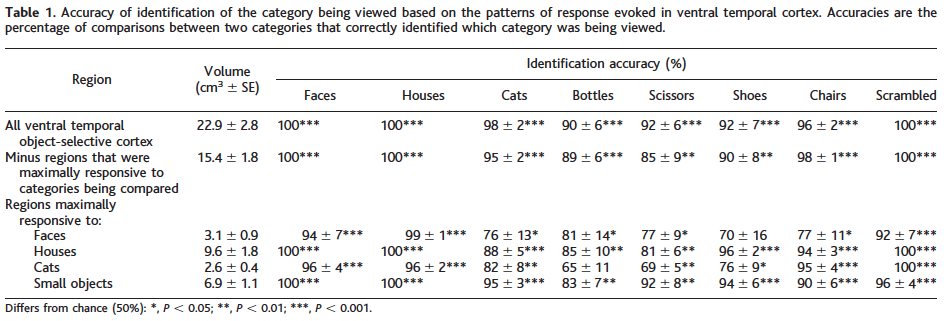
"All 66 regions were active in at least one domain; 65 (98.5%)
were active in two or more domains. [...] The 66 regions were active in an
average of 9.09 (SD 2.27) different domains. The 60 regions active in
action tasks were also active in an average 7.38 (SD 0.98) non-action
domains and 5.5 (SD 0.81) cognitive domains. The 64 regions active in
perception tasks were also active in 7.39 (SD 1.87) non-perceptual domains
and 5.34 cognitive domains. The 59 regions active in both perception and
action tasks were also active in an average of 5.53 (SD 0.80) other
domains, and the 7 regions not active in both perception and action tasks
were active in an average of 3.00 (SD 1.41) of the cognitive domains. Only
one region was active in only cognitive tasks, and that region was active
only in memory."
— Anderson, M. L. (2010).
Neural reuse: A fundamental organizational principle of the brain
Behavioral and Brain Sciences
33:245-266.
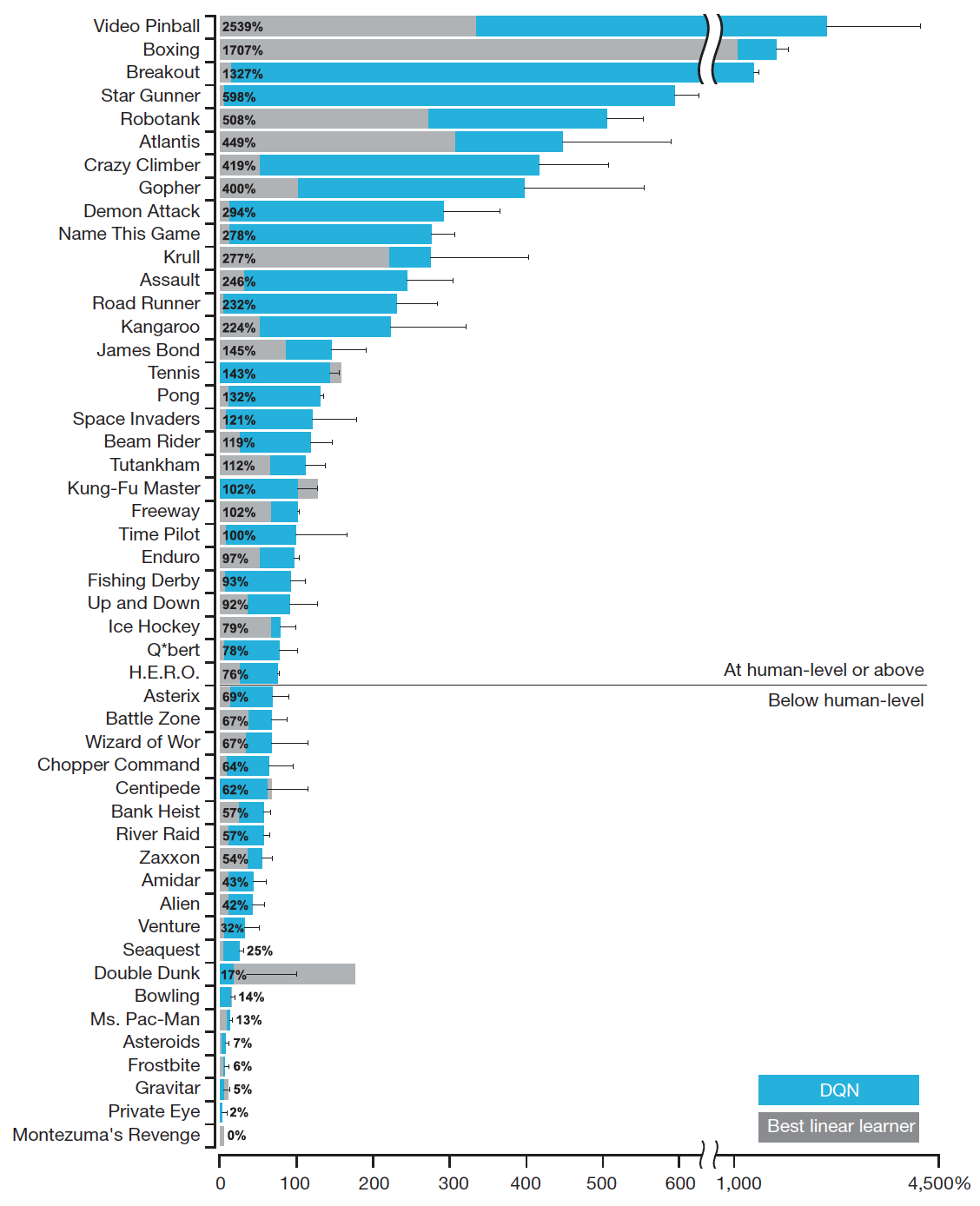
Mnih, V., et al. (2015). Human-level control through deep reinforcement
learning. Nature 518:529-533.
"games demanding more temporally extended planning strategies still constitute a major challenge for all existing agents [...] (for example, Montezuma's Revenge)."
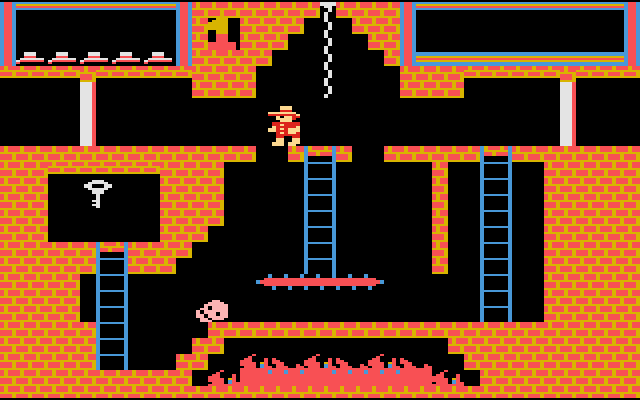
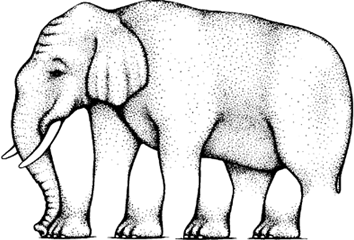
Four case studies — four approaches to understanding the brain, and their limitations:
Last modified: Tue Jun 25 2019 at 15:15:46 EDT